Click on the map below to learn more

 |
Lake VictoriaAt 26,600 square miles in size, Lake Victoria is Africa's largest lake, and the largest tropical lake in the world, and the second largest freshwater lake in the world. Only Lake Superior in the United States is larger. Lake Victoria is shallow compared to other large lakes with an average depth of 140 feet and a maximum depth of 276 feet. Much of the lake's original ecosystem has been destroyed by invasive species such as the Nile perch and the water hyacinth. |
| Back to Map | |
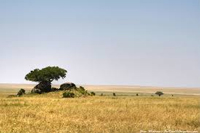 |
Serengeti National ParkSerengeti National Park is one of the world's most famous wildlife refuges and a UNESCO World Heritage site. Each year over 350,000 people visit to see , among other things, the incredible wildebeest and zebra migrations. It is thought that over 1.5 million wildebeest and 250,000 zebra migrate through the area. The park covers 5,700 sq. miles and is characterized by vast areas of savanna, grassland plains, and forests. Lions, leopards, cheetahs, crocodiles, ostriches, rhinos, hippos giraffes, elephants, and many other animals can be found in the park.
|
| Back to Map | |
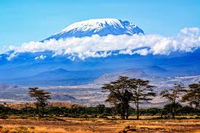 |
Mt. KilimanjaroAt 19,341 feet, Mt. Kilimanjaro is one of the most iconic mountains in the world. It is also the highest peak in Africa. Mt. Kilimanjaro is actually a giant stratovolcano with three domes. Two of the domes are extinct, but the third, named Kibo, is dormant. It is thought that Kilimanjaro last erupted sometimes between 150,000 and 200,000 years ago. Kilimanjaro is a popular climbing destination, although it is not as challenging as mountains in the Himalayas or Andes ranges. It was first ascended in 1889. In February of 2019, a ten-year-old boy named Theodore Margoroli became the youngest person to climb Kilimanjaro. Like many great mountains of the world, climate change is impacting Mt. Kilimanjaro. Its ice fields and glaciers are rapidly shrinking. |
| Back to Map | |
 |
DodomaDodoma is the capital city of Tanzania. It has a population of about 410,000. Dodoma was founded by German workers constructing the Tanzanian central Railway in 1907. In 1973, the Tanzanian government moved the capital city from Dar es Salaam on the east coast of the nation, to the centrally-located Dodoma. Organizers of the move believed moving the capital would improve the lives of those living in central Tanzania. |
| Back to Map | |
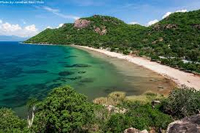 |
Lake MalawiLake Malawi is one of a series of lakes in Africa known as the African Great Lakes. It is the world's ninth largest lake and the third largest lake in Africa. It is home to thousands of species of fish - more than any other lake, including over 700 species of chiclids. Chiclids are often sold as aquarium fish (such as the angelfish) or eaten as delicacies (such as talapia). Lake Malawi is famous for its huge swarms of lake flies that are so dense, they can be seen for miles away. |
| Back to Map | |
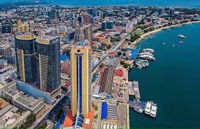 |
Dar es SalaamDar es Salaam is the largest city in Tanzania. Until 1974, it was the nation's capital before it was moved to Dodoma. With a population approaching 5,000,000, Dar es Salaam is one of the world's fastest growing cities and the largest Swahili-speaking city in the world. By some estimates, Dar es Salaam will be one of the world's largest cities by 2100. It remains the cultural, economic, and political center of Tanzania and the entrance point to the country for the majority of those who visit. In 1998, the Dar es Salaam Stock Exchange was established. |
| Back to Map | |
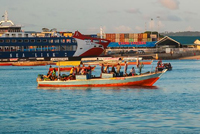 |
Zanzibar IslandZanzibar Island, now called Unguja, is located near the east coast of Tanzania. It is the largest and most populous of a chain of islands known as the Zanzibar Archipelago. Zanzibar has been inhabited for at least 20,000 years. It is well known as an ancient trading center that served as a convenient meeting point for trade between Arab merchants and Swahilis. In 1499, the famous Portuguese explorer Vasco da Gama visited Zanzibar and by 1504, it became part of the Portuguese empire. Later it became a well-known center of the brutal Arab slave trade. 40,000 to 50,000 slaves were brought to Zanzibar every year to work on clove or coconut plantations. |
| Back to Map | |
| Population: | 55,572,000 (2014) |
| Area: | 365,756 sq. miles |
| Capital City: | Dodoma |
| Largest City: | Dar es Salaam |
| Currency: | Tanzanian Shilling |
| Official Language: | Swahili |
| GDP (Gross Domestic Product) | $186.06 Billion (91st) |
|
|
 |
|
| The green in the Tanzanian flag represents nature's beauty, the yellow represents the country's vast mineral riches, the black represents the people, and the blue represents its great lakes. | |